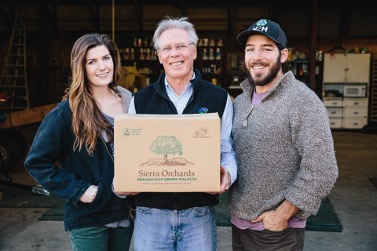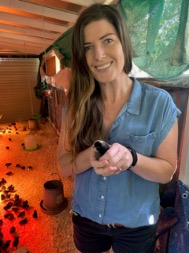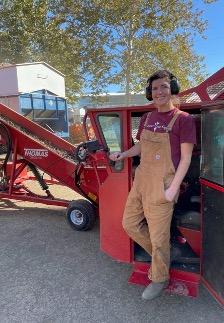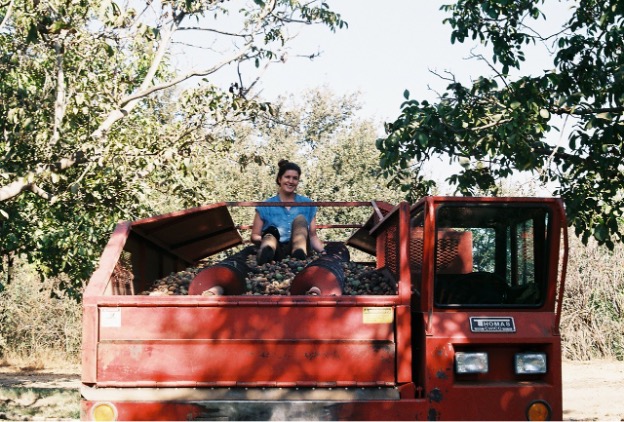Emily McNamara is more than just a scientist and more than just a farmer. Having grown up on Sierra Orchards, a family farm in Winters, California, she completed her undergraduate education at Brown University and her Master’s at Duke University. She has complemented these two academic experiences with her journeys to such places as India, Vietnam, Mexico, and farms all over California in order to learn and ultimately implement various alternative agricultural techniques and philosophies at Sierra Orchards. Her work is a wonderful model of mindful engagement with landscapes and their complex histories. We thank her for the time and thought she gave to this interview, and we are sure you will be inspired!
1. Describe how agriculture played a role in your youth.
Nature has always played a role in my life. Since a very young age, I have explored along the Putah Creek by our home, as well as gone hiking, backpacking, camping, and kayaking. I’ve played among the trees and orchards and held birthday parties in this natural space.
But the fact that we were farming on a large scale never really clicked as a child. I’d always ride in the walnut buggies during harvest or play in the irrigation ditches, and my dad would take us on tomato harvesters in the summers through our neighbor’s fields. But I didn’t fully comprehend the actual scale on which we farmed until I was older.
I think that separation is just because I was doing kid stuff – school, friends, and extracurricular activities – and because this is such a finely tuned and mechanized system. People always ask me if I worked on the farm growing up. But because we have such a highly efficient system, there was no room for me to randomly pop in here and there.
In college, when I came home for the summers and worked at local internships, I started to become a bit more involved. When I graduated, this involvement increased. My first post-grad job was for an ag tech startup called California Safe Soil (CSS) in Sacramento that takes food waste from grocery stores and converts it into liquid fertilizer. While traveling throughout California, I fully realized the special and unique aspects of our farm and what my parents had created in the last 40 years. That’s when my mind began to shift, and I started to think about farming here for my full-time job.
2. What does working on a family farm mean to you?
In a word, it’s powerful. When we were younger, my dad would ask my brothers and me who would be coming back to the farm, but we always had other plans. I studied policy and environmental studies in undergrad, then was a dive instructor in Mexico and worked on a marine park, before starting work for California Safe Soil.
That is when the seed was planted to come back to ag, but I really wanted to explore the intersection between corporations and local food systems and how those could be more integrated. I was specifically interested in how we could source from local food systems, especially in California, to provide more access at a corporation level. That is what brought me to the Duke Environmental Management program. At Duke, I really made the decision that I had to get back to the family farm. There were decisions being made that I wanted to be a part of.
No experience was going to prepare me for this aside from just jumping right into it. At that time, we started working as a family on succession and general communication skills. The fact that my family has had such openness to working on our communication and listening skills and interacting as one strong family unit really made this transition a lot easier. Family businesses can be difficult; there’s not a lot of separation between work and family life, and those lines can be blurred. But having the ability to communicate and express feelings and emotions in a welcoming environment really makes us have much more rich and exciting experiences. At the end of the day, we’re in this together: struggles, successes, and everything in between.
3. How have your travels influenced the ways you perceive the food system?
I feel blessed because my parents always encouraged travel and exploration to learn about different cultures, places, and peoples. We traveled throughout Mexico and Central and South America growing up. When I was in college and post-college, I had the opportunity to explore India and Vietnam and other countries around the world. From my youth, learning about food systems through travel was always a priority instilled by my parents.
Whether it was sugar cane fields in Mexico, or diverse farming in Vietnam, local farming techniques and indigenous farming systems across the world have been drastically influenced and damaged by Americanized big ag, like Monsanto seeds and pesticides. That really struck me. In recent years, I’ve seen and heard more about the push for local food systems to return to their natural and native forms as part of resilient landscapes. Now we are making the same push for sustainability on our farm, especially as we tackle climate change and resource loss.
4. What was your master’s project about, and what did you discover?
My master’s project analyzed the efficacy and feasibility of pollinator bee certifications for almond growers in California. The almond bloom is the largest pollination event in the world with millions of hives transported across the country to California each spring.
In the last few decades, they’ve noticed a dramatic decline in managed honeybee populations. The research has shown that providing more diversified nutrients through hedgerows and cover crops can increase their vitality and their ability to deal with different diseases or pests. I wanted to see what the challenges and hardships were for almond growers and if they would be interested in implementing bee friendly practices.
I surveyed over 300 almond farmers. And overall, I found that producers do desire a bee-friendly practice. They’re very concerned about the wellbeing and health of their beehives because the industry relies on pollination. But still, bee-friendly practices are not widely adopted. The adoption rates and barriers for implementing bee-friendly practices differ by region, which showed me that there is a need for a new certification.
This certification needs to be effective in supporting pollinator health and not be totally greenwashed, but it also must be feasible for growers to implement. In ag, it is not uncommon for someone with a strictly environmental research background or tech background to think that they have the solution, but to have not fully talked to the farmers about what they are capable of implementing, what they want to do, and where they need help. Barriers like funding, access to equipment, time, and labor still exist. These barriers differ by region, so there is no one-size-fits-all solution.
5. What roles do you play at Sierra Orchards?
Because it’s a family farm, we each wear many hats. Even our year-round farm team wears many hats. I currently manage our pasture raised hen operation that we started right when I came on.
I’m also doing the marketing and branding for our farm to try to find more markets through which we can reach our customers and diversify our product streams and market avenues. For the last 40 years, we’ve always sold our organic walnuts to a larger distributor who then distributes them to stores like Costco and Trader Joe’s; we’ve never sold them under the Sierra Orchards label. But that is one interest of mine going forward.
I’m also involved in researching and implementing more sustainable irrigation techniques and monitoring our irrigation and water use. Sometimes I work with grant writing. During the walnut harvest, I drive the bank out wagon, which follows and empties out the harvester before running back to an elevator that puts the nuts in a trailer.

6. How is Sierra Orchards preparing for a future that will be shaped by climate change?
We are researching how we can continue to farm this land in a sustainable and regenerative way while being responsible stewards. Climate change is constantly in the forefront of our minds, as it is with all farmers, whether or not they choose to call it that. It may take the form of serious droughts or chill hours – consecutive days of cold temperatures that walnuts require to set.
As we look towards the future, we have to think about not only how we will continue farming walnuts, but also other crops. How can we continue to diversify? What will water and heat stress and lack of chill hours look like in the future, and how will we be able to protect this land for ourselves and our community?
We have to take out our home acreage, which is 60 acres, because the trees are at least 65 years old and are no longer at their highest productivity. We still have other walnut acreage, but we are also looking into organic almonds, which have some self-fertilizing varieties.
7. How does food justice factor into your work?
Food justice is incredibly important to our family. My dad started the Center for Land-Based Learning 25 years ago, which is a nonprofit that focuses on connecting youth with ag and our regions, ecosystems, and landscapes. It now operates in 27 counties throughout California.
Education and exposure to our lands and food allows us to reach more youth and more schools to address what can be done to increase access to more nutrient dense foods. My dad has also participated in Alice Waters’ Edible Schoolyard Project. From a young age, getting the right foods in schools has been something that I’ve been passionate about. We donate and volunteer, but there’s always more to do. I’ve been on the farm now for a year and a half working full-time, and though I’ve donated and educated myself and interacted, it’s just increasing my want and need to connect more with our community.
There is a huge disconnect between people and where their food comes from, but there is also a bounty of food in California and in our nation. We need to figure out a system to get it into food deserts or food apartheids and ensure that a child does not go to school hungry because that affects every layer of their learning and well-being.
8. Can you tell us more about the Center for Land-Based Learning?
It’s a nonprofit that really focuses on connecting youth with ag, land, and the natural, native ecosystems of our region. They set up urban gardens and urban farms, tying into that issue of access. They started a program called the Farm Academy, which is for people of all different ages who really want to learn about farming, but don’t quite have the means to start. It is a seven-month intensive program in which students receive a great deal of hands-on and classroom-based education. They support those interested in continuing to pursue farming by helping them rent a quarter acre plot.
The Center for Land-Based Learning focuses on racial gaps as well. It started with inner-city and underfunded schools, where nature and land are not as readily accessible. It gives students an opportunity to get into an open space and to do things with their hands and to interact with the natural world, which is incredible.
9. Sierra Orchards offers a beautiful land acknowledgement statement at the top of the website; what are some specific steps the farm has taken to tap into and honor indigenous knowledge in the name of regenerative agriculture?
This is such an important question, especially as a white landowner. We take the idea of stewardship very seriously, and we acknowledge that we are guests here until the land is one day returned to its original owners. Education is critical to us. We are trying to continuously learn more about the history of the land we farm and the indigenous populations whose lands were stolen from them. A land acknowledgment is only a small step forward. While we integrate indigenous practices into our farming, such as our incorporation of animals into our landscape and the harmony we feel with nature (as opposed to a sense of domination over it), we also recognize that we often let our day-to-day tasks and pressures get in the way of building relationships with our local indigenous community. We hope to become better stewards by tapping into more knowledge and skills as we evolve.

10. Describe the importance of rotational grazing and your recent role in introducing chickens to the farm.
Rotational grazing acts as a natural tilling system. Sheep hooves and chicken talons mix organic matter into the soil and help sequester carbon. Animals also add necessary nutrients into our soil in the form of manure, and they reduce the need for mechanical mowers and diesel engines. Now we only mow about once a year. Chickens are also great pest control and can get up into the bark of trees for insects.
Introducing the chickens has been an exciting and challenging experience. We introduced them about a year and a half ago, when they kind of fell into our lap; one perk of a family farm is that sometimes things just spontaneously happen, and you have the freedom to make it work.
Now we have almost 900 chickens. We collect their eggs twice a day, wash them, and package them. Then we sell them to restaurants throughout Sacramento and the Bay Area. We also sell them to more boutique butcher shops that source locally, as well as community kitchens and (for a time) farmer’s markets. Never having done this before, it’s been interesting navigating what to do with the eggs during COVID, but I’m finally figuring it out.
11. What happens with the olives Sierra Orchards produces?
We have 170-year-old Mission olive trees that line and border some of our property. We started harvesting those ten or fifteen years ago. One of our neighbors has an olive press, and so he started pressing our olives into olive oil. It’s not a large-scale operation, and production differs year by year because they are so old and were not bred for high productivity. So we save the olives for friends and family.
12. Sierra Orchards’ closed-loop composting system is a large operation visible throughout the farm. How common and how feasible is such a project on other farms?
Sean, my brother, started this about five years ago. We are seeing more composts made on farms in California, but it’s still fairly uncommon for walnut growers and processors to compost their whole material like we do. That’s probably because it has to be done during harvest, which is the busiest time of the year. Having the time, skilled labor, and knowledge of getting it organized and prioritizing it as well, when everything else is going on, is a challenge.
It also requires some machinery: a loader and a tractor, which are fairly common in larger scale orchard operations; but also a compost turner, which is a more expensive piece of equipment and not as common. Those would probably be the biggest challenges, but if there were a program that could educate people or help them rent machinery, large-scale closed-loop composting could become more common.
13. What were the barriers in reaching a soil healthy enough to employ no-till practices?
It is really a question of how we make up for the processes that were achieved by tilling. People till to mix in organic matter, suppress weeds, and break up soil aggregates. Conversely, we plant a very diverse cover crop that includes plants like daikon radish, which have incredible taproots that penetrate really hard soil. That allows more soil pores to form through root systems and aeration to occur. The sheep and chickens also mix in the top layer. Through those practices, we’ve been able to achieve what people turn to tilling to do.
However, I do recognize the monetary costs of transitioning to no-till, cover cropping, and animal agriculture. Different types of soil are also decisive in how easy it is to move away from no-till; we don’t have a ton of hard clay in our soil like there is in North Carolina. Just like with my master’s project, I have found that we have to examine opportunities through a critical regional and farm-based lens.

14. You have many research projects that take place on the farm. Why is this so integral to the farm’s mission?
Science is knowledge, and allowing our farm to be a platform for research enhances our knowledge of best farming practices, allowing us to ensure that the soil and the general ecosystem can continue to thrive on the land.
We are also grateful to be able to provide a space for people to grow in their own research and knowledge as well. Connecting with UC Davis and other private and public research institutions has been a part of our farm since the beginning. It teaches us more about this landscape and what we can do to better protect it.
15. What has been your favorite research project that Sierra Orchards has supported?
I love the bats, and though I wasn’t here for the installation of the bat boxes, I fully enjoy reaping the benefits of the bats being around. We worked with researchers at the University of California Cooperative Extension(UCCE) to set up bat boxes around our farm. At about 7 pm, they all fly out of their boxes at the same time, and it is really amazing to watch. They are incredible pest managers. The most common bat that we have is the Mexican free-tailed bat and the pallid bat. They weigh about half an ounce to an ounce, and they can eat up to two thirds of their body weight in insects. Unfortunately, there has been a huge decline in their populations elsewhere due to a loss of roosting sites.
16. Describe water management practices at Sierra Orchards; how are both quality and quantity preserved?
Again, there is always more to learn and more to do, but we have implemented quite a few practices. In the early days, we used to practice flood irrigation. For that, we created a tailwater pond, which trapped the runoff from the irrigation system that also had that really special and coveted topsoil in it. Then we would dredge out that tailwater pond and reapply the top soil. The water from that pond would eventually go back into the aquifer.
We also work closely with the Putah Creek Council. This creek flows along our farm and borders part of it. I have worked with them to restructure the creek back into its natural form. This included the removal of tons of invasive species and guiding the floodplains back into their original scape and form. That has allowed for better drainage and less sediment going into the water systems.
During heavy rain years, we conduct aquifer recharges. We haven’t had those in a while, but in more recent years, I’ve been doing something called pressure bombing, which is a way to note when and how much we actually need to irrigate the trees. Incorporating technology like that allows us to use our irrigation water much more efficiently and effectively. We don’t want to waste water, but we also don’t want to underwater the trees, which would damage their root systems and reduce their water retention capacity.
We have had quite a few irrigation systems, and they have changed over time. It is a huge and very expensive process to redo an irrigation system on an orchard scale. We are looking into a SWEEP grant right now for this next orchard removal process so that we can revitalize the irrigation system and make it much more effective.

17. In an increasingly digital world, how can we raise youth interest in agriculture and cultivate the next generation of farmers?
There are two parts to consider: how do we raise all people’s interest in ag, and how can we make farming more accessible?
Helping all people understand the importance of where our food comes from is critical to changing our food system for the better and making it more resilient and accessible to people nationwide. If care and interest were more substantial, people would be able to more effectively advocate for the foods they want, as well as where and how they want their food to be grown.
It’s very important to cultivate the next generation of farmers, but the reality in California is that it is so hard to be a farmer unless you’re second generation or have a ton of money. Land prices and natural resource scarcity are major barriers. It’s important to be able to provide the right tools to those who are seriously interested, like the farm academy is doing, but we also have to be realistic about the financial strain and overall hardship that farming can entail. My dad is 72 and works from 5:00 AM to 7:00 PM. It’s really hard. So we also need to figure out how to better support farmers, especially small and midsize farmers, so that they can continue farming and caring for the land in the most mindful way possible. We don’t want to lose our farms to giant monopolies or banks.
Solutions are rooted in discussion, and I think the digital world could be used to get the word out. We especially need to intentionally break outside of our bubbles. It’s easy for someone to say that people need to see a certain documentary, or that they need to farm their own food or shop at a farmer’s market. But the truth is, that’s not everyone’s reality. That kind of lifestyle is not accessible to everyone. And so figuring out how to form more bridges and connections is really important.
18. What else is in the future for Sierra Orchards?
We meet twice a week as a little family farm unit, and the question of the future is always on the forefront of our agenda. Of course, we are going to remove the old walnut trees, and we are looking at different sales techniques, whether it’s more business-to-business or direct-to-consumer. We are thinking about additional value-added goods and how we can more fairly share our land and resources with our community. Always, we are committed to balancing proper land stewardship with financial sustainability so that we can continue to thrive and farm the right way, while continuing to give back and feed people with high-quality, nutrient-dense foods.
 Food
Food Farmers
Farmers Sustainable Living
Sustainable Living Living Planet
Living Planet News
News